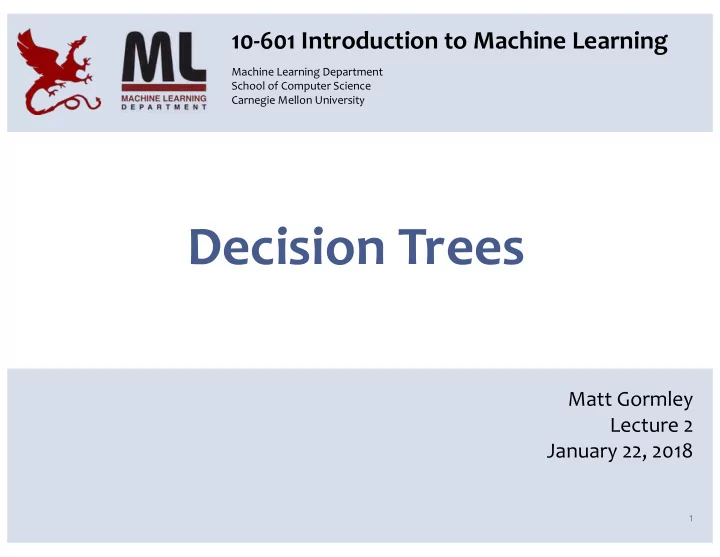

10-601 Introduction to Machine Learning Machine Learning Department School of Computer Science Carnegie Mellon University Decision Trees Matt Gormley Lecture 2 January 22, 2018 1
Reminders • Homework 1: Background – Out: Wed, Jan 17 (today) – Due: Wed, Jan 24 at 11:59pm – Two parts: written part on Canvas, programming part on Autolab – unique policy for this assignment: unlimited submissions (i.e. keep submitting until you get 100%) 2
ML as Function Approximation Chalkboard – ML as Function Approximation • Problem setting • Input space • Output space • Unknown target function • Hypothesis space • Training examples 3
DECISION TREES 4
Decision Trees Chalkboard – Example: Medical Diagnosis – Does memorization = learning? – Decision Tree as a hypothesis – Function approximation for DTs – Decision Tree Learning 5
Tree to Predict C-Section Risk (Sims et al., 2000) 6 Figure from Tom Mitchell
Decision Trees Chalkboard – Information Theory primer • Entropy • (Specific) Conditional Entropy • Conditional Entropy • Information Gain / Mutual Information – Information Gain as DT splitting criterion 7
Tennis Example Dataset: Day Outlook Temperature Humidity Wind PlayTennis? 8 Figure from Tom Mitchell
Tennis Example Which attribute yields the best classifier? H =0.940 H =0.940 H =0.985 H =0.592 H =0.811 H =1.0 9 Figure from Tom Mitchell
Tennis Example 10 Figure from Tom Mitchell
Decision Tree Learning Example In-Class Exercise Dataset: Output Y, Attributes A and B 1. Which attribute would Y A B misclassification 0 1 0 rate select for the 0 1 0 next split? 1 1 0 2. Which attribute 1 1 0 would information 1 1 1 gain select for the 1 1 1 next split? 1 1 1 3. Justify your answers. 1 1 1 11
Decision Trees Chalkboard – ID3 as Search – Inductive Bias of Decision Trees – Occam’s Razor 12
Overfitting Consider a hypothesis h and its • Error rate over training data: • True error rate over all data: We say h overfits the training data if Amount of overfitting = 13 Slide from Tom Mitchell
Overfitting in Decision Tree Learning 15 Figure from Tom Mitchell
How to Avoid Overfitting? For Decision Trees… 1. Do not grow tree beyond some maximum depth 2. Do not split if splitting criterion (e.g. Info. Gain) is below some threshold 3. Stop growing when the split is not statistically significant 4. Grow the entire tree, then prune 16
Split data into training and validation set Create tree that classifies training set correctly 17 Slide from Tom Mitchell
18 Slide from Tom Mitchell
Questions • Will ID3 always include all the attributes in the tree? • What if some attributes are real-valued? Can learning still be done efficiently? • What if some attributes are missing? 19
Learning Objectives You should be able to… 1. Implement Decision Tree training and prediction 2. Use effective splitting criteria for Decision Trees and be able to define entropy, conditional entropy, and mutual information / information gain 3. Explain the difference between memorization and generalization [CIML] 4. Describe the inductive bias of a decision tree 5. Formalize a learning problem by identifying the input space, output space, hypothesis space, and target function 6. Explain the difference between true error and training error 7. Judge whether a decision tree is "underfitting" or "overfitting" 8. Implement a pruning or early stopping method to combat overfitting in Decision Tree learning 20
Recommend
More recommend